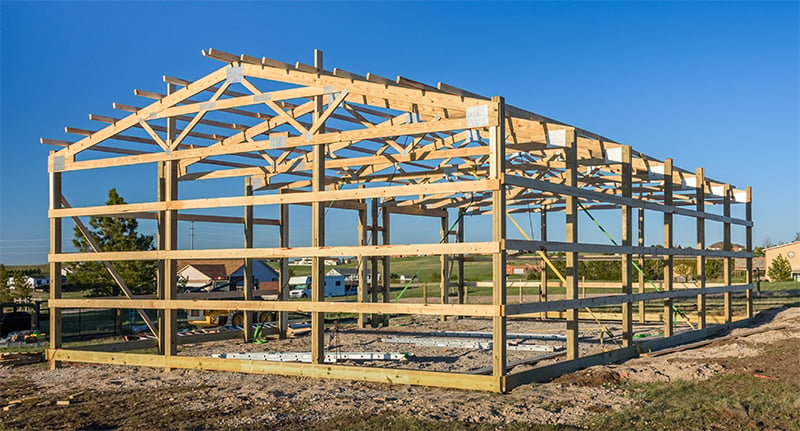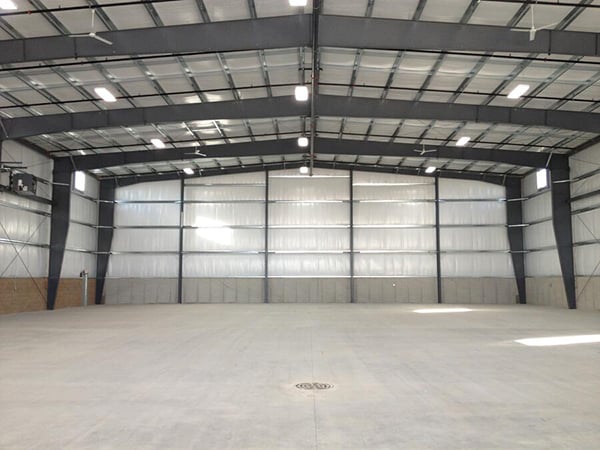Pole building.…steel building….metal building.…pole barn….
Same thing, different name, right? Wrong!
Although they can appear similar on the outside, the differences between a wood-framed structure (pole building, pole barn, pole shed, post-frame building) and a pre-engineered metal building (steel building, metal building) are pretty significant.
Below, we highlight the differences between pole buildings and metal buildings and why these differences are important to consider as you decide what best fits your needs.
Metal Building vs Pole Barn
The main difference between a pole barn and a metal building is the method of structural construction and level of durability.
What Is a Pole Barn?
Pole barns have an interior frame made of wood with exterior metal panels. They are also called pole buildings or post-frame buildings because wood posts are placed vertically in the ground or on a concrete foundation to support the structure’s outer walls and roof trusses. The structures can either be heated or unheated and can be built in a variety of different configurations and sizes.
What Is a Metal Building?
Metal buildings are constructed with completely non-combustible materials. Rather than wood structural components, these buildings have structural steel frames, steel walls, and a steel roof system. Metal buildings can be designed to accommodate nearly endless uses, sizes, and building configurations.
Unlike pole buildings, metal buildings are pre-engineered and pre-designed, meaning all parts are fabricated in a controlled environment to exact dimensions and assembled later on site. This prefabrication process leaves little to no room for human error during construction, guaranteeing a solid and sturdy structure.

Pole buildings have an interior frame made of wood.
Building Materials: Wood vs Steel Construction
One of the most obvious differences between pole barns and metal buildings is the building materials themselves— Pole barns are supported by wood-framed structures, while metal buildings are supported by metal-frame structures. Below, we compare the two types of building structures, helping you see how metal is the superior building material.
Wood-Frame Structures
Wood is a cost-effective material that is readily available and easy to construct. However, there are some vulnerable traits of a wood-framed structure that should be considered:
- Wood is susceptible to weather damage like rot, mold, and natural deterioration.
- Wood is a combustible material and can catch fire if exposed to extreme heat, sparks, or flame.
- Wood can be damaged by insects, lightning, birds, and other animals.
- Moisture and extreme heat and cold can cause wood to split, check, and shrink, allowing the bolts and screws to loosen and the structure to shift, warp and sag.
Metal-Frame Structures
Metal is one of the strongest and most durable building materials on the market. A metal or steel building can provide decades of maintenance-free shelter and protection from the elements with proper design and maintenance.
Below are some additional benefits of steel-frame structures:
- Metal provides greater structural strength, making it suitable for larger and taller buildings.
- Metal frames are inherently more fire-resistant than wood frames, reducing the risk of fire damage.
- Metal frames offer more design flexibility and can accommodate various architectural styles and building requirements.
- Metal frames are often made from recycled materials and are recyclable, making them a sustainable and eco-friendly choice for construction.
Did you know A.C.E. Building Service offers pre-engineered steel buildings for industrial and commercial purposes? Take a look here to learn more now

A steel building can provide decades of maintenance-free shelter and protection from the elements.
Roof Systems
Another key difference between a pole barn and a metal building is the roofing system. Most metal buildings are constructed with a standing seam metal roof, whereas pole buildings have a mechanically fastened roof secured with screws.
With a pole barn roofing system, the screws are installed through the metal roof panel and into the wood framing, creating hundreds or thousands of potential leak points in the roof of the building. In comparison, a standing seam metal roof is designed and installed to allow expansion and contraction, making the lifespan more than double that of a mechanically fastened roof.
Learn about Butler’s MR-24® Metal Re-Roof System.
Design Factors to Consider When Choosing Between a Metal Building and a Pole Barn
Two main design factors to consider when choosing between a pole barn or metal building are the frame spacing options and ease of insulation installation. For example, pole buildings typically have structural posts ranging from 6’ to 8’ on center, offering stability but potentially limiting interior design options.
On the other hand, pre-engineered steel buildings typically have frames ranging from approximately 20’ to 30’ on center, providing a cleaner interior appearance and greater flexibility for door and window placement.
When heating is required for a pole barn, an attic space must be constructed. This attic space then needs to be sealed off to accommodate insulation, adding an additional construction step. Large pole buildings requiring sprinkler systems also need secondary dry systems in the attic.
By way of their design, steel buildings do not have attic spaces and do not require these additional provisions. The insulation is installed at the same time as the roof panel, creating a finished ceiling and building envelope in one step.
Which Is Cheaper: Pole Barn or Metal Building?
Pole buildings are cost-effective solutions for smaller constructions, typically limited to clear spans of 60’ to 80’ and eave heights around 20’. However, exceeding these boundaries can quickly escalate costs, making them less practical for larger projects.
On the other hand, steel buildings offer greater versatility, accommodating wider clear spans, taller eave heights, longer lengths, and specialized features such as large hanger doors and heavy equipment housing. These buildings span a size range from small to massive structures, offering more flexibility in design and functionality, giving you a range of design options at any price point.
Don’t need a massive building or huge doors? A metal building might still be right for you. They are easily constructed, highly adaptable structures suitable for both commercial and private applications. Oftentimes, a metal building will drive lower insurance costs than a pole building and offer many more years of maintenance-free use.
Start desiging your metal building project now! Check out our metal building gallery to explore common building sizes and get a cost estimate.
Why Choose A.C.E. Building Service?
A.C.E. Building Service provides metal building design and construction services for commercial, industrial, and manufacturing operations in Manitowoc, Sheboygan and Wisconsin’s lakeshore area.
We are proud to partner with Butler Manufacturing, and be a part of the largest network of construction professionals in the world to provide our clients with the best steel buildings in the industry.
Are you interested in learning more about our service and seeing if a metal building is the right choice for you? Request a quote online or call us today. We look forward to hearing from you!








